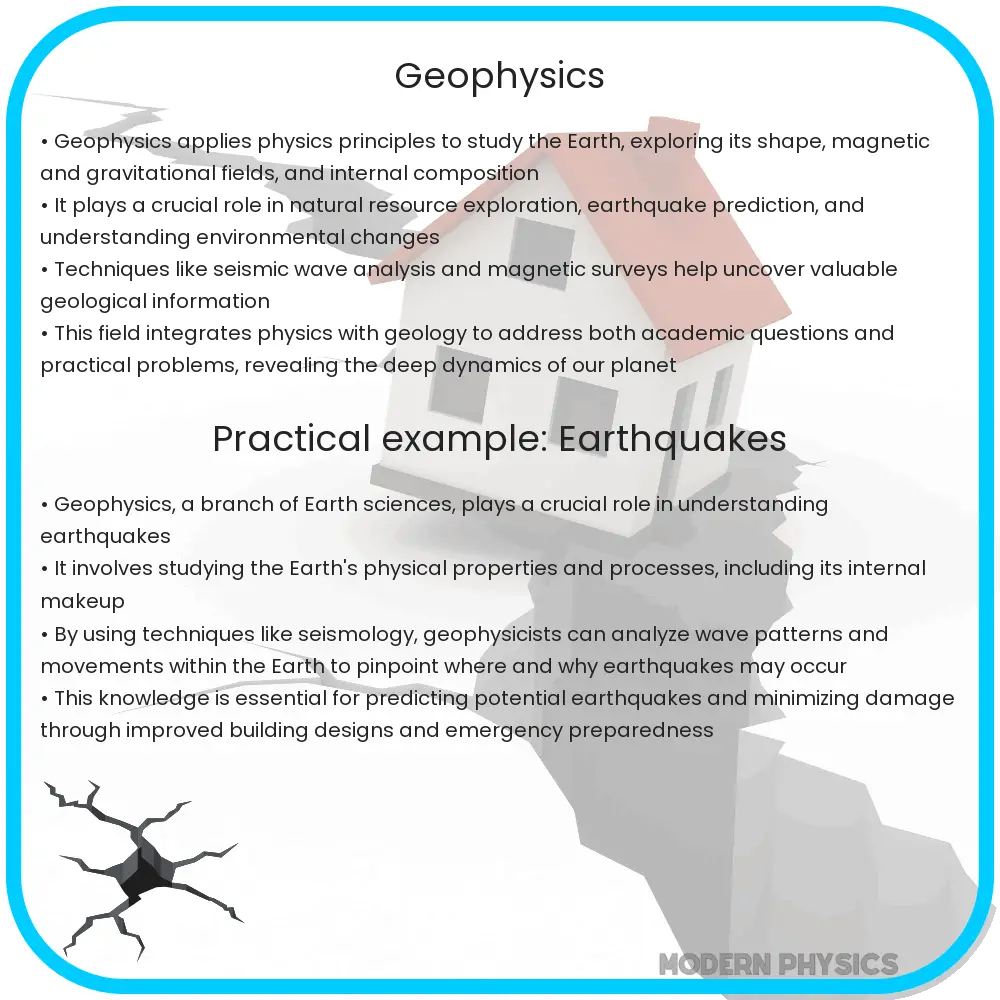Explore the fascinating world of geophysics, a field that uses physics to study Earth’s structure, resources, and natural hazards, driving forward exploration and sustainability.

Introduction to Geophysics: Unveiling Earth’s Mysteries
Geophysics, a pivotal branch of Earth sciences, harnesses the principles of physics to explore and understand Earth’s structure, composition, and processes. This interdisciplinary field combines various techniques and technologies to delve deep beneath Earth’s surface, offering insights into our planet’s past, present, and future. Geophysical methods are indispensable in natural resource exploration, environmental protection, and mitigating natural hazards.
Core Areas of Geophysics
Geophysics encompasses several core areas, each focused on different aspects of Earth’s physical properties and phenomena. These include:
- Seismology: The study of earthquakes and the propagation of elastic waves through the Earth or other planet-like bodies. Seismologists analyze seismic waves to map Earth’s interior and assess earthquake risks.
- Geodesy: This field involves measuring and understanding Earth’s geometric shape, orientation in space, and gravitational field, providing essential data for mapping and navigation technologies.
- Magnetotellurics: An exploration technique that examines the Earth’s subsurface electrical conductivity, influenced by its temperature, composition, and fluid content, crucial for identifying mineral and geothermal resources.
- Gravimetry: The measurement of Earth’s gravity field variations to infer the subsurface density distribution, aiding in the exploration of oil, gas, and minerals.
Geophysical Exploration Techniques
Geophysical exploration employs a wide range of techniques to image the subsurface, each with its advantages and applications:
- Seismic Reflection and Refraction: These methods use the reflection and refraction of seismic waves to create detailed images of the subsurface. They are crucial in oil and gas exploration and in understanding Earth’s crustal structure.
- Electromagnetic Methods: Techniques such as magnetotellurics and induced polarization measure the Earth’s electromagnetic fields to detect subsurface anomalies related to mineral deposits or groundwater.
- Gravity and Magnetic Surveys: These surveys map variations in Earth’s gravity and magnetic fields to infer geological structures and locate mineral resources.
Each geophysical technique offers a window into the Earth’s complex interior, enabling scientists to assemble a more comprehensive picture of its structure, dynamics, and history. The integration of data from multiple geophysical methods enhances the accuracy and depth of Earth exploration and analysis.
Advancements in Geophysical Data Analysis
Recent advancements in computational power and data analytics have transformed geophysical data analysis, enabling more sophisticated and precise interpretations of the Earth’s subsurface. High-performance computing allows for the processing of large geophysical datasets, improving the resolution and accuracy of subsurface models. Additionally, machine learning and artificial intelligence (AI) are increasingly applied to geophysical data, aiding in pattern recognition, anomaly detection, and predictive modeling, thus enhancing our ability to predict natural hazards and discover resources.
Applications of Geophysics in Earth Exploration
Geophysics plays a critical role in addressing some of the most pressing challenges and opportunities facing humanity. Applications include:
- Resource Exploration: Identifying and quantifying natural resources such as oil, gas, minerals, and geothermal energy, facilitating sustainable extraction and management practices.
- Environmental Monitoring: Assessing and monitoring soil and groundwater contamination, land subsidence, and the integrity of natural habitats to mitigate environmental impacts.
- Natural Hazard Assessment: Predicting volcanic eruptions, earthquakes, and landslides, contributing to disaster preparedness and mitigation efforts.
- Archaeological Exploration: Non-invasively probing beneath the Earth’s surface to discover and study archaeological sites, preserving historical and cultural heritage.
Conclusion
The field of geophysics is a cornerstone of our understanding of Earth’s processes and structures. By applying principles of physics to the study of the Earth, geophysicists provide invaluable insights that drive progress in resource exploration, environmental stewardship, and natural hazard mitigation. The integration of cutting-edge technologies and methodologies in geophysics continues to push the boundaries of Earth exploration, revealing the hidden complexities of our planet. As we face global challenges such as resource depletion, environmental degradation, and climate change, the role of geophysics in providing the data and insights needed for sustainable management of Earth’s resources and natural systems becomes increasingly vital. Embracing the advancements in data analysis and maintaining a multidisciplinary approach are key to unlocking the full potential of geophysics in understanding and protecting our planet for future generations.
